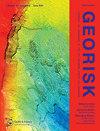基于物理模型的区域性台风引发滑坡危险性评价——以中国东南地区为例
IF 4.8
3区 工程技术
Q1 ENGINEERING, GEOLOGICAL
Georisk-Assessment and Management of Risk for Engineered Systems and Geohazards
Pub Date : 2023-03-16
DOI:10.1080/17499518.2023.2188465
引用次数: 5
摘要
本文章由计算机程序翻译,如有差异,请以英文原文为准。
Hazard assessment for regional typhoon-triggered landslides by using physically-based model – a case study from southeastern China
ABSTRACT Landslide hazard assessment is an important component of risk management and land-use planning. This study aims to investigate the application of a physically-based model named after the fast shallow landslide assessment model (FSLAM) to rainfall-triggered landslide hazard assessment. In August 2015, a total of 123 landslides induced by Typhoon Soudelor in Wenzhou City, southeastern China, was taken as an example. Five input raster files (elevation, soil types, vegetation, antecedent rainfall, event rainfall) and two parameter files regarding soil properties and vegetation were determined. Considering the randomness and uncertainty of soil and vegetation parameters on the regional scale, FSLAM model computes the probability of failure (PoF) by using random parameters inputs. Finally, the landslide hazard map was generated for the study area to reflect the landslide risk. The results showed that FSLAM could accurately capture the effect of rainfall on PoF of slopes, and more than 70% of the landslide were identified in very high/high hazard zones. The accuracy of the receiver operating characteristic (ROC) reached 0.720, which was higher than that of the Transient Rainfall Infiltration and Grid-Based Regional Slope-Stability (TRIGRS) model (0.620). Regarding the computational time, FSLAM had better efficiency, and the consuming time was 1/25 compared with TRIGRS.
求助全文
通过发布文献求助,成功后即可免费获取论文全文。
去求助
来源期刊
CiteScore
8.70
自引率
10.40%
发文量
31
期刊介绍:
Georisk covers many diversified but interlinked areas of active research and practice, such as geohazards (earthquakes, landslides, avalanches, rockfalls, tsunamis, etc.), safety of engineered systems (dams, buildings, offshore structures, lifelines, etc.), environmental risk, seismic risk, reliability-based design and code calibration, geostatistics, decision analyses, structural reliability, maintenance and life cycle performance, risk and vulnerability, hazard mapping, loss assessment (economic, social, environmental, etc.), GIS databases, remote sensing, and many other related disciplines. The underlying theme is that uncertainties associated with geomaterials (soils, rocks), geologic processes, and possible subsequent treatments, are usually large and complex and these uncertainties play an indispensable role in the risk assessment and management of engineered and natural systems. Significant theoretical and practical challenges remain on quantifying these uncertainties and developing defensible risk management methodologies that are acceptable to decision makers and stakeholders. Many opportunities to leverage on the rapid advancement in Bayesian analysis, machine learning, artificial intelligence, and other data-driven methods also exist, which can greatly enhance our decision-making abilities. The basic goal of this international peer-reviewed journal is to provide a multi-disciplinary scientific forum for cross fertilization of ideas between interested parties working on various aspects of georisk to advance the state-of-the-art and the state-of-the-practice.

 求助内容:
求助内容: 应助结果提醒方式:
应助结果提醒方式:


